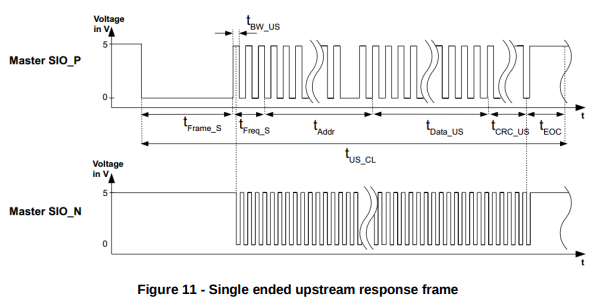At the electrical level, the protocol used for single-ended mode looks a lot like I²C or 1-wire with the lines being pulled normally-high. You could bit-bang this protocol or (if you need better performance) you could use the microcontroller's FLEXIO functionality. As shown in the INLC10AQ datasheet starting from page 12, the protocol for single-ended mode is as follows:
The microcontroller holds the
SIO_Nline high to indicate single-ended mode then writes output bits to theSIO_Pline by pulling the line low. The signal is self-clocking. This is shown on page 12 of the datasheet:

When done sending the microntroller switches its IO pins to be inputs and the
SIO_PandSIO_Nlines are pulled high. To send a response, the peripheral chips pull theSIO_Pline low to indicate0bits while at the same time providing a clock signal by pullingSIO_Nlow. This is shown on page 14:

For single-ended operation the VIL,SE and VIH,SE are given on page 8 of the datasheet:
Since the parameters are from the perspective of the peripheral chip (the INLC10AQ) they are given as input voltages, not outputs (i.e. as VIL,SE and VIH,SE rather than VOL,SE and VOL,SE). On the microcontroller end you'll need to pull the voltage down to 1.04V or lower to send a 0 bit or pull it up to between 1.08V and 5.5V1 to send a 1 bit. Likewise, the peripheral INLC10AQ will connect a line to GND to indicate a 0 or leave it pulled high to indicate a 1 (the peripheral never actively pulls a line high; it goes high-impedance to indicate a 1). The datasheet doesn't recommend a particular value for the pull-ups but 4.7kΩ would be a good starting point.
1 The datasheet lists 5.5V as the maximum recommended high voltage (VCC5); 7V is the absolute maximum.

